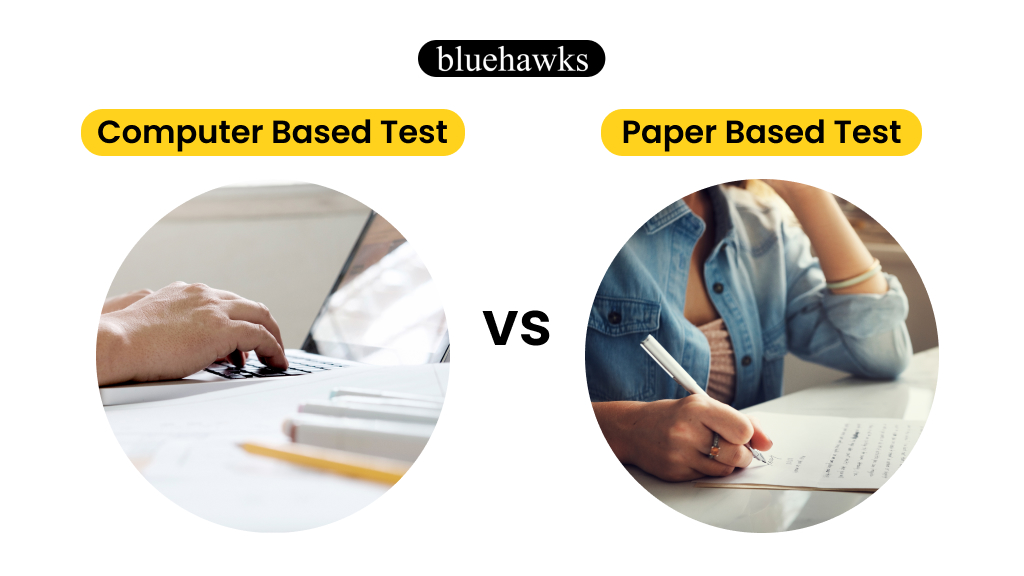IELTS Computer Based Test vs Paper Based: Key Differences

IELTS Computer Based Test vs Paper Based: Key Differences
In 2017, the International English Language Testing System (IELTS) introduced computer-based testing, initially launching this format in Australia before expanding its availability to various regions across the globe. Understanding the key distinctions between computer-based and paper-based IELTS is essential for test takers. Individuals who have experience with the paper-based IELTS will be familiar with the fact that the Listening, Writing, and Reading sections involve physical paper tasks, while the Speaking assessment is conducted face-to-face with trained examiners. The computer-based version maintains the same structure, but it requires candidates to input their responses on a computer interface rather than using pen and paper.
A Brief Introduction to Paper Based and Computer Based IELTS
In the paper-based IELTS test, the Reading, Listening, and Writing sections are to be answered on the examination paper itself. Speaking test in this case, will be carried out with a trained IELTS examiner through a face-to-face interview.
Computer-based IELTS will have the Reading, Listening, and Writing sections taking place on a computer. The Speaking test is held in the face-to-face method with IELTS examiners. The examination is completed on the same day for both paper and computer-based formats. The Speaking section may be completed up to one week after or prior to the other tests.
1. Test Format:
- Paper-Based Test (PBT): In the PBT format, the test-taker is given a physical test booklet containing the questions. You must write your answers on the answer sheet provided.
- Computer-Based Test (CBT): In the CBT format, the entire test is taken on a computer. You will read and answer the questions on the computer screen.
2. Listening Test:
- Paper-Based Test: In the PBT, the listening test is administered using a CD player, and you listen to the audio through headphones.
- Computer-Based Test: In the CBT, the listening test is played through the computer’s speakers or headphones. You can adjust the volume as needed.
3. Reading Test:
- Paper-Based Test: In the PBT, you read the passages and answer the questions on the paper test booklet.
- Computer-Based Test: In the CBT, you read the passages on the computer screen and answer the questions on the computer.
4. Writing Test:
- Paper-Based Test: In the PBT, you write your responses with a pen or pencil on the answer sheet provided.
- Computer-Based Test: In the CBT, you type your essay responses using the keyboard provided.
5. Speaking Test:
- Paper-Based Test: The speaking test in the PBT is conducted face-to-face with an examiner.
- Computer-Based Test: The speaking test in the CBT is a recorded interview where you respond to pre-recorded questions. There is no live interaction with an examiner.
6. Test Results:
- Paper-Based Test: With the PBT, you typically receive your results 13 days after taking the test.
- Computer-Based Test: Results for the CBT are usually available within 5 to 7 days after the test.
7. Test Availability:
- Paper-Based Test: PBTs are scheduled on specific dates at designated test centers.
- Computer-Based Test: CBTs offer more flexibility as they are available on multiple dates throughout the year, and you can choose a date and time that suits you.
8. Test Environment:
- Paper-Based Test: PBTs are conducted in a traditional classroom-like setting, with test-takers sitting at desks.
- Computer-Based Test: CBTs are taken in a computer lab with individual workstations.
9. Test Experience:
- Paper-Based Test: Some test-takers prefer the tactile experience of writing with a pen or pencil on paper and find it easier to annotate and underline text on paper.
- Computer-Based Test: CBTs can be more convenient for those comfortable with technology, as you can easily edit and revise your answers on the computer.
10. Score Reporting:
- Paper-Based Test: Scores are reported in half-band increments (e.g., 6.5, 7.0, 7.5). –
- Computer-Based Test: Scores are reported in whole-band increments (e.g., 6, 7, 8).
Key Advantages and Disadvantages of Computer and Paper-Based IELTS
While the candidate have ascertained the difference between computer-based and paper-based IELTS formats, here are some major advantages and disadvantages.
Advantages of Computer-Based IELTS:
- Enhanced Test Environment: Smaller rooms or venues with fewer test-takers can provide a more conducive environment for concentration and reduced stress.
- Flexibility in Test Timing: Some CBT centers offer flexibility in choosing the exam time, including morning or afternoon slots, before or after the Speaking test, allowing candidates to pick a time that suits them.
- Quick Results: Test-takers receive their results more swiftly, typically within 5-7 days, reducing the waiting period.
- Word Count Visibility: In the Writing section, the word count is displayed on the screen, eliminating the need for manual word counting.
- Improved Listening Experience: Individual headphones for the Listening section ensure clearer audio and better focus.
- Timed Alerts: On-screen timers change color to indicate 10 minutes and 5 minutes remaining for the Reading and Writing tests, respectively.
- No Handwriting Concerns: Candidates need not worry about the quality of their handwriting, which can be a concern in the paper-based format.
- Easy Editing: Content can be edited conveniently, and text can be highlighted with a right-click in the Reading and Listening tests.
- Customization: Test-takers can adjust screen settings, such as text color and size, to their preferences.
- Volume Control: Listening volume can be adjusted as needed.
- Navigation Tools: A navigation bar on the screen allows candidates to track their progress, revisit questions, and review answers.
- Time Management: Candidates can manage their time, move forward and backward within the test, and review answers within the overall time limit.
- Auto-Save: Answers are automatically saved, eliminating the need for manual saving or pressing Enter. Changes can be made to answers at any time.
Disadvantages of Computer-Based IELTS:
- Screen Fatigue: The 3-hour duration of the test on a computer screen can be physically and mentally tiring for some candidates.
- No Drawing/Writing: In the Writing Task, candidates cannot draw or write, which may limit expression for some test-takers.
- Transferring Answers: Unlike the paper-based format, there is no extra 10 minutes for transferring answers after the Listening test. Instead, there is additional time between sections and two minutes at the end for checking.
- Simultaneous Listening and Typing: Candidates must click and drag or type answers directly while listening, which can be challenging for some.
- Distractions: Typing noise from other candidates may be distracting in the computer-based test centers, though some centers provide noise-canceling headphones and quieter keyboards.
- Typing Speed: Candidates not used to typing may find it slower than writing by hand.
- Multi-Tasking: Simultaneously listening and typing can be challenging for those unaccustomed to such tasks.
- Limited Practice Opportunities: There may be fewer opportunities for practice tests on a computer.
- Computer Skills Required: Basic computer skills, including scrolling, clicking, navigating, clearing, highlighting, copying, pasting, dragging, and typing, are necessary.
Advantages of Paper-Based IELTS:
- Writing and Drawing: Candidates can write and draw, particularly in the Writing section, allowing for greater expression and brainstorming.
- Physical Annotation: Candidates can quickly circle, underline, and practice words before writing them on the answer sheet, which is a preferred method for many.
- Minimal Computer Skills: Candidates do not need advanced computer skills and can focus solely on the test content.
- Typing Not Required: Candidates are not required to type answers, potentially speeding up their response time.
- Extra Time for Transferring Answers: An additional 10 minutes at the end of the Listening section is provided for transferring answers to the answer sheet.
Disadvantages of Paper-Based IELTS:
- Word Counting: Candidates must manually count words while writing.
- Limited Editing: Tracking progress and editing or changing answers is more challenging on paper.
- Handwriting Quality: Illegible handwriting can lead to issues with answer interpretation.
- Transferring Answers: Transferring answers to the answer sheet carries the risk of errors.
- Concentration Challenges: Examination venues may be crowded with more candidates, potentially affecting concentration.
- Slower Results: Results take longer to obtain, usually beyond 7 days.
- Limited Flexibility: Candidates may have limited flexibility in choosing test times and dates.
Frequently Asked Questions
Question. How are the speaking and listening tests conducted in the IELTS Computer-Delivered Test?
Answer. The speaking test is conducted face-to-face with an examiner, while the listening test is done using headphones and a microphone.
Question. Are the content and difficulty level the same in both formats?
Answer. Yes, the content and difficulty of the test are identical in both formats. The questions, topics, and scoring criteria are the same.
Question. Which format should I choose, CBT or PBT?
Answer. Your choice depends on personal preferences and familiarity with technology. Consider factors like your comfort with typing, ability to concentrate on a computer screen for an extended period, and the availability of test dates at your preferred test center.
Question. How long does it take to get the results for CBT and PBT?
Answer. CBT results are usually available within 5 to 7 days after the test, while PBT results typically take around 13 days.
Question. Do I need to have strong computer skills for CBT?
Answer. Basic computer skills, such as typing, clicking, and navigating, are sufficient for CBT. The test interface is user-friendly, and there is no need for advanced computer proficiency.
Question. Can I use a spell-checker or grammar-checker in the CBT writing section?
Answer. No, you are not allowed to use external tools like spell-checkers or grammar-checkers during the CBT writing section. Your responses should be your own work.
Question. Can one change the IELTS test format from Paper-based to Computer-based?
Answer. Students need to contact their test center directly to change from an IELTS paper-based test to a computer-based test. Changing from IELTS paper-based test to a computer test means that the candidate will be receiving all the required devices and equipment for the test.
Question. Do Universities accept computer based IELTS?
Answer. Every university accepts IELTS scores of either computer-based or paper-based test, and students should feel free to choose any version of the test. The computer-based IELTS test excludes the problem of handwriting and is for those who have a good speed in typing.
Question. How is computer-based IELTS marked?
Answer. The computer-based test’s IELTS Reading and Listening sections are marked automatically by the computer, whereas trained examiners still grade the Writing and Speaking sections.



